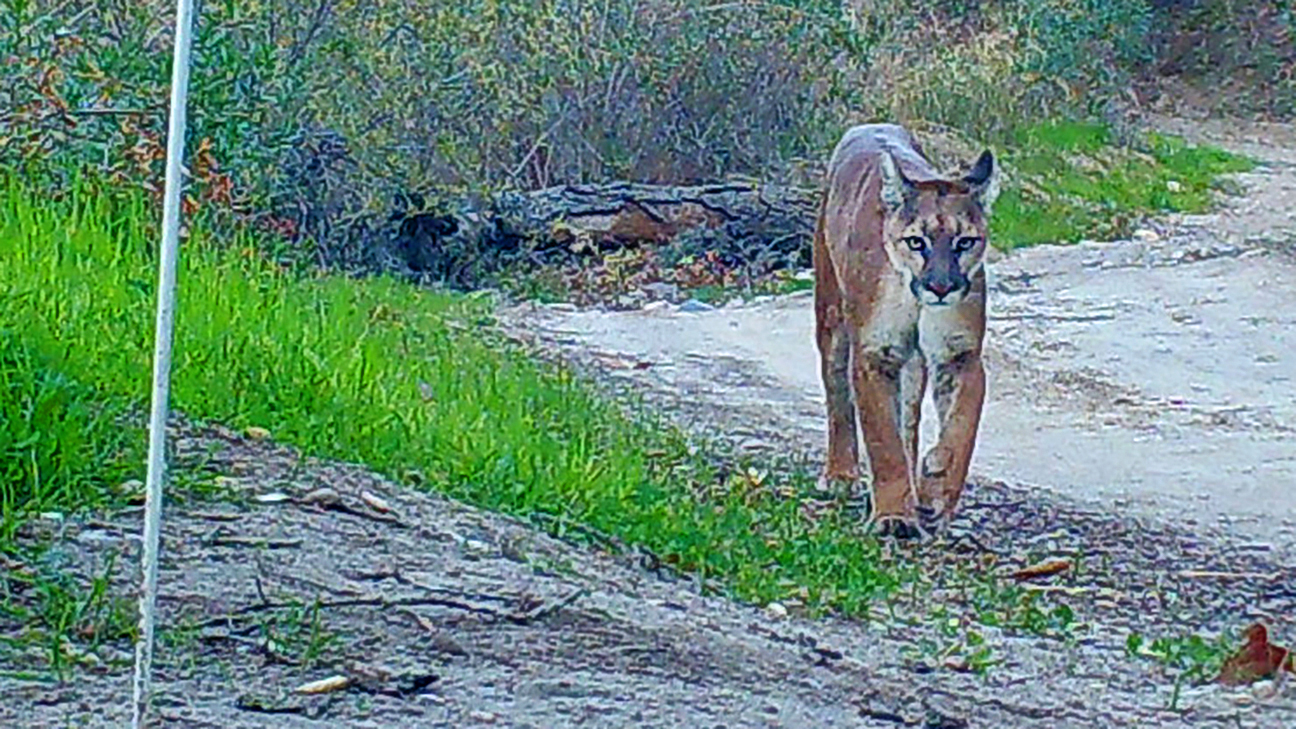New evidence from a mountain lion attack of a little boy on Labor Day weekend while enjoying a family picnic in a state park in the Santa Monica Mountains, suggests the attack may not have been as unexpected as reported.
Data from a necropsy of the euthanized puma, and findings in a recent study on human attacks and knowledge from a wildlife veterinarian who specializes in mountain lions suggest that the attack on Sept. 1 checked all the boxes that contribute to lion-verses-human incidents.
Mountain lion cub Holly was orphaned in the Santa Cruz mountain area earlier this year and is now housed at Big Bear Alpine Zoo in Big Bear Lake on Thursday, July 20, 2023. (Photo by Terry Pierson, The Press-Enterprise/SCNG) © The Press-Enterprise/SCNG
The family reportedly relocated to Woodland Hills from war-torn Ukraine after losing their home. They were picnicking at the Tapia Park Day Use Area near Malibu Canyon Road in unincorporated Calabasas when a mountain lion sprang from the underbrush, locked onto the 5-year-old boy’s head with its jaw and started to run with him. The boy’s father pounced on the lion, causing the animal to release the child, saving his life.
Richard Fink, California State Park superintendent, told the media: “Lions do attack young kids.” After the attack, he said one of his rangers saw the lion in a tree and she appeared to be lying in wait. The ranger shot and killed it.
The boy sustained significant but non-life-threatening injuries to his face, neck and head, and is recovering at home, authorities reported. His aunt told KTLA news: “It is getting only worse. He started to remember everything and he is terrified. The pain on his scars is terrible.”
While most experts repeated that mountain lion attacks are rare, that didn’t explain why one of the mountain lions living in the Santa Monica Mountains would go after a little boy. To answer that question, new data and other contributing factors were analyzed.
A hungry puma
The most obvious reason is the mountain lion was looking for food.
A necropsy on the animal revealed it was a juvenile female, as young as 12 months old and up to 16 months old. The procedure found no contents in its stomach, said Capt. Patrick Foy, with the California Department of Fish and Wildlife (CDFW) enforcement division in Sacramento on Sept. 10.
“The mountain lion was a little bit underweight,” he said. It weighed 52.8 pounds. An adult female weighs on average 90 pounds, he said. “It had an empty stomach, so probably it was hungry.”
Females do the hunting in the mountain lion society. They usually learn how from their mothers. The National Parks Service estimates there are 12-15 cougars in the Santa Monica Mountains, and several have been seen in the Calabasas area in the last few years, including two attacks on children in three years.
Scientists keep track of those they’ve attached with radio collars, which transmit their whereabouts and data on their behavior. But this young cougar did not have a collar, so little is known about her origins or travels.
T. Winston Vickers, a wildlife veterinarian and researcher with the UC Davis Wildlife Health Center, is an expert on Southern California mountain lions. In an interview on Sept. 10, he speculated the female lion may have been separated from her mother prematurely and didn’t fully learn how to hunt. A mountain lion’s main source of food is deer.
“Any animal that small would not be able to take down a big deer,” he said. Because female lions’ diets vary more than males, she may have been hunting smaller mammals. “So it might have had a more willingness to look at another animal, a human,” Vickers said.
Also, being young could mean it hadn’t learned to stay away from humans, what he called “a contrary pattern” adopted by adult mountain lions.
An analysis of mountain lion vs. human interactions found that children, and smaller adults, are overrepresented in mountain lion attacks, he said.
A 2011 study on the risk factors associated with cougar attacks on humans concluded that female cougars were more likely to attack people than male cougars.
Also, children 10 years of age or younger were more likely to be attacked than adults.
The study looked at 386 human-cougar encounters. It also found that attacks increased from the 1970s through the 1990s, as did fatalities. But it concluded that interactions with people were rare in both Canada and the United States.
The female wildcat did not have rabies or any organ diseases, Foy said. It was not tested for rodenticide poisoning, something many other mountain lions suffer from in the Santa Monica Mountains after ingesting smaller animals that were poisoned by household rat poison.
Vickers said up to eight mountain lions have died recently of bird flu and suggested the CDFW test for that, since bird flu can affect the brain and behavior.
The necropsy was performed by the California Animal Health and Food Safety Laboratory in San Bernardino, Foy said.
Safe in a picnic area?
While picnic areas are made for humans who can barbecue meats or eat prepared foods, and are designed for families with children, that doesn’t mean they’re free from roaming cougars. This one is located within a park that has been known for its mountain lion sightings.
In fact, Vickers said a picnic area attracts racoons, skunks, squirrels and rabbits who are hanging around waiting for table scraps. Female mountain lions are keenly aware these smaller animals visit picnic areas, he said.
“These places attract raccoons, skunks and other scavenger animals that can be food for the lions,” he said. “It can cause predators to hang around these areas more often.”
Also, in hot weather, deer will stop to drink at a mountain stream. The park where the attack occurred has a creek with water. “These mountain lions like water; they like riparian areas,” Vickers said.
Past attacks
The Malibu Creek State Park is in the heart of the Santa Monica Mountains and may have been where the famous “Hollywood Cat” P-22 came through before he settled into Griffith Park. He died after being hit by a car in December 2022.
A news report on the latest attack said a maintenance worker saw a mountain lion at the Tapia day use area two weeks or so before the Sept. 1 attack.
Both mountain lions and black bears have been spotted in people’s backyards next door in the city of Calabasas fairly routinely, often showing up on outdoor video footage shared on social media sites, said Mayor Alicia Weintraub.
A mountain lion visited the backyard of her home last year in the early morning. “It was quite scary to me,” she said.
Since 1986, there have been about 26 human attacks in the state, with four fatalities. In the last two years, there have been six attacks in the state, with one fatality.
Three years ago, a boy, also age 5, was attacked by a mountain lion also in Calabasas, according to CDFW records. He was dragged across the front lawn of his home when his mother ran out of the house and struck the animal with her bare hands, causing the lion to let go.
Foy told the news media the mother saved her son’s life. He recovered from his injuries. That day, a CDFW officer found the lion crouching in the bushes, “ears back and hissing,” the department reported. The officer shot the animal who was deemed a public threat.
On March 23, two brothers were attacked by a mountain lion at 2,800 feet elevation in the Eldorado National Forest in El Dorado County. Taylen Robert Claude Brooks, 21, was killed and Wyatt Jay Charles Brooks, 18, was severely injured.
A post left on the CDFW Facebook site regarding the Malibu Creek park attack from Amanda Welsh, the boys’ mother, read: “Only 5 months since my boys attack. Thank goodness the boy survived but he and everyone involved will now have lifelong trauma.”
The attack in El Dorado County was the first fatality from a mountain lion attack in the state since January 2004, when a mountain lion attacked and killed 35-year-old Mark Reynolds, while he was riding his mountain bike in Whiting Ranch Wilderness Park in Orange County. Hours later in the same park, a mountain lion attacked and injured a 30-year-old woman bicyclist.
Since then, the park has had several mountain lion vs. human encounters that forced several periods of park closures.
Rick Grant, 68, of Reseda, met Reynolds at mountain bike races in Big Bear and Running Springs in the 1990s. They’d chit-chat in the parking lot about bike brands and racing, Grant said.
“I don’t know if he stopped but the cat overcame him and killed him,” said Grant on Sept. 12. Every year since 2005, he makes a donation to the Mark Reynolds Fund, which raises money to buy bikes for kids who can’t afford them.
At the top of “Dreaded Hill” at the Orange County park, there’s a plaque that reads: “Mark J. Reynolds, 1968-2004. He was doing what he loved.”












